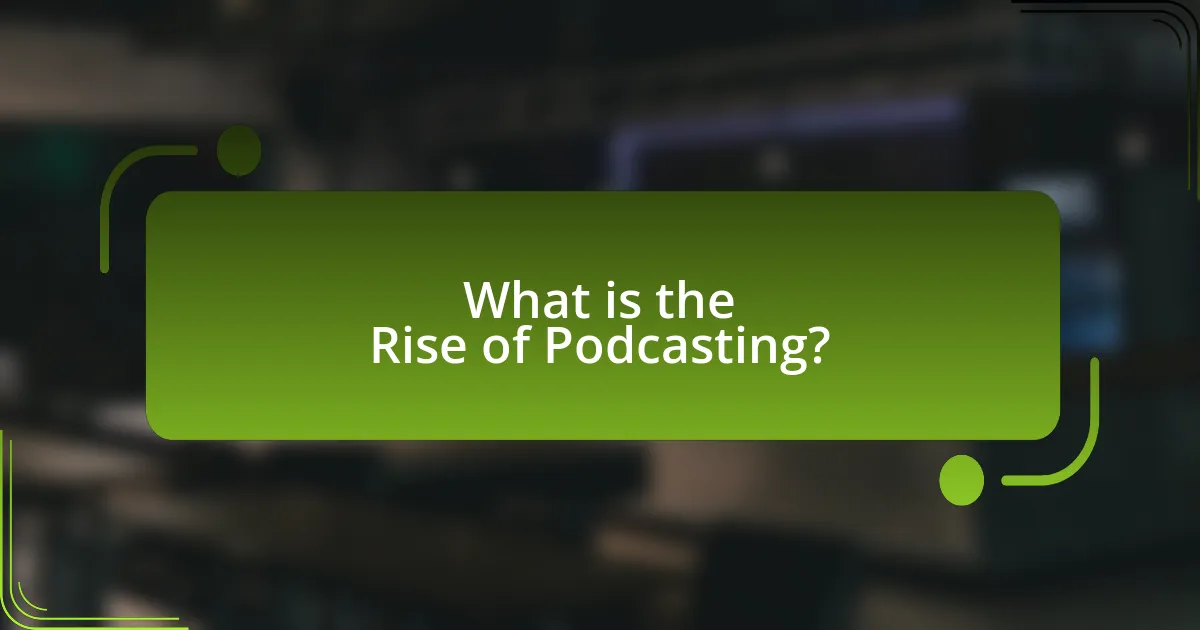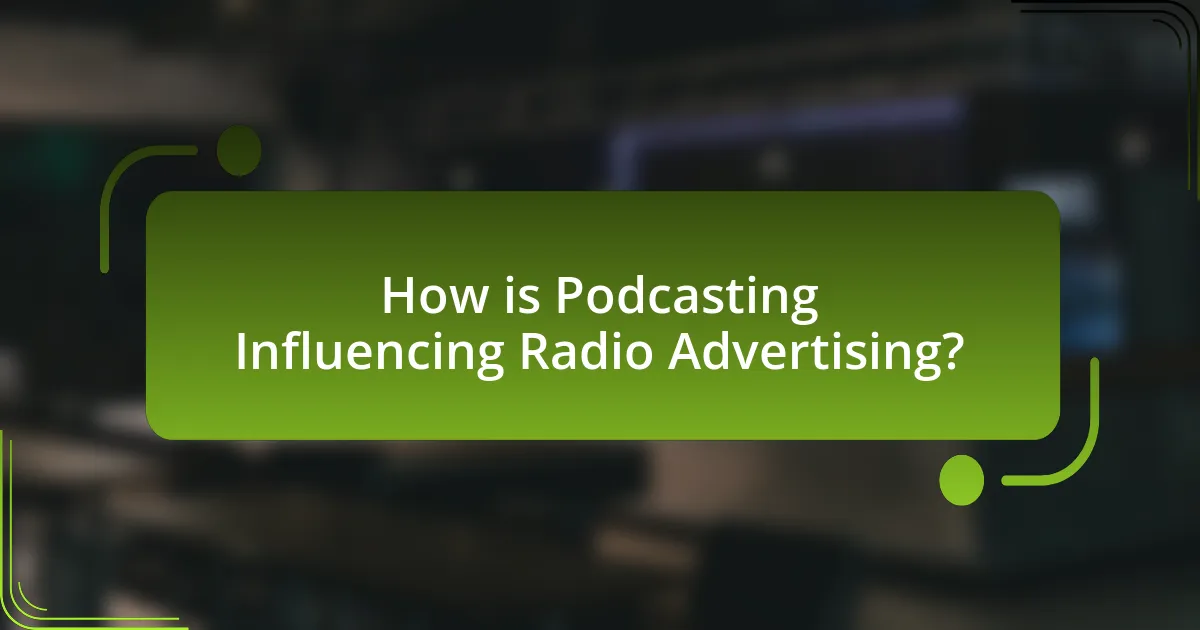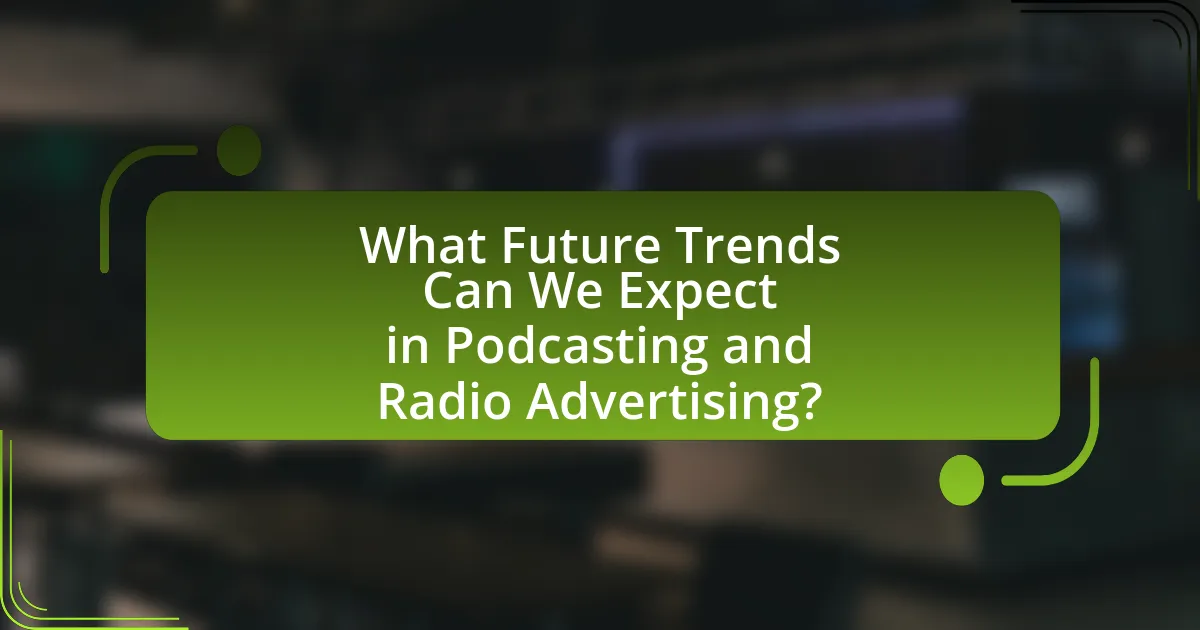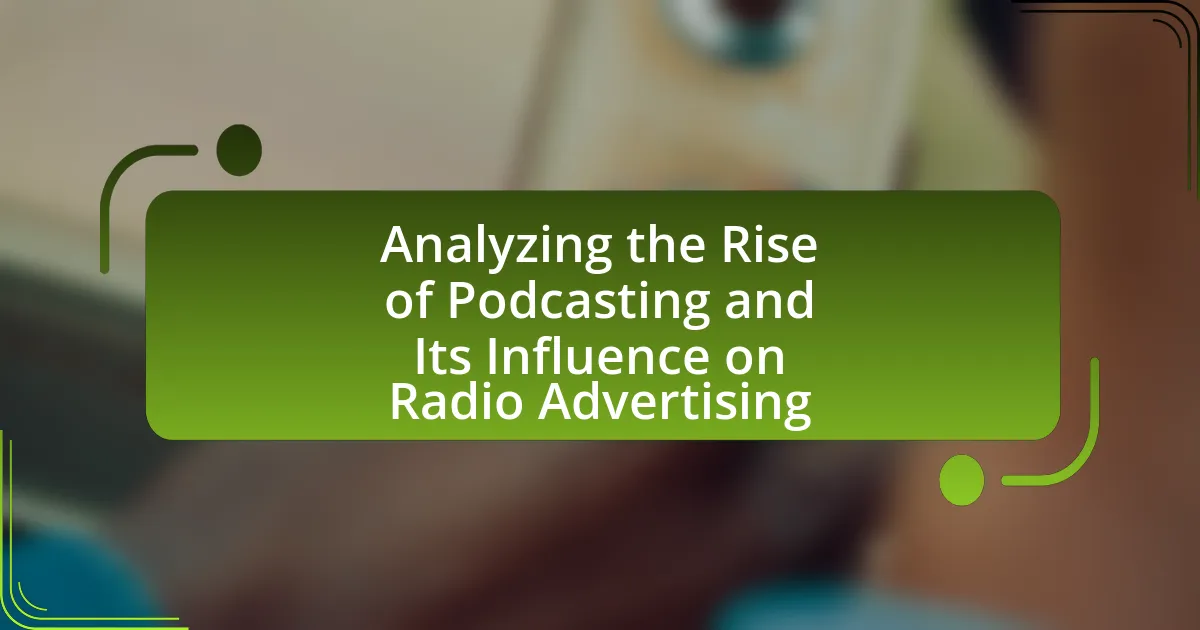The article analyzes the rise of podcasting and its significant influence on radio advertising. It highlights the growth of podcast listenership, which has surpassed 400 million globally, and the increasing number of podcasts, exceeding 2.5 million as of 2023. The piece discusses the evolution of podcasting from a niche hobby to a mainstream medium, driven by technological advancements and changing audience engagement patterns. Additionally, it examines how advertisers are reallocating budgets from traditional radio to podcasts due to their targeted advertising capabilities and higher engagement rates, while also addressing the challenges faced by radio advertisers in adapting to this shift.

What is the Rise of Podcasting?
The rise of podcasting refers to the significant increase in the popularity and consumption of audio content delivered through digital platforms, particularly since the early 2000s. This growth is evidenced by statistics showing that as of 2023, over 400 million podcast listeners exist globally, with the number of podcasts exceeding 2.5 million. The accessibility of podcasting technology, combined with the rise of smartphones and streaming services, has enabled creators to reach diverse audiences, leading to a shift in how people consume media. Additionally, the podcasting industry has attracted substantial advertising revenue, projected to surpass $2 billion in 2023, indicating its growing influence on traditional media, including radio advertising.
How has podcasting evolved over the years?
Podcasting has evolved significantly since its inception in the early 2000s, transitioning from a niche hobby to a mainstream medium. Initially, podcasting was primarily used by tech enthusiasts and independent creators, but by the 2010s, it gained traction with the launch of platforms like Apple Podcasts and Spotify, which facilitated easier access and distribution. According to Edison Research, as of 2023, over 80 million Americans listen to podcasts weekly, highlighting the medium’s growth in popularity. Additionally, the rise of podcast networks and the introduction of monetization strategies, such as sponsorships and listener donations, have further solidified podcasting’s role in the media landscape, influencing traditional radio advertising by attracting advertisers seeking to reach engaged audiences.
What technological advancements have contributed to podcasting’s growth?
Technological advancements such as the proliferation of high-speed internet, the development of mobile devices, and the emergence of user-friendly podcast hosting platforms have significantly contributed to podcasting’s growth. High-speed internet allows for seamless streaming and downloading of audio content, making it accessible to a wider audience. Mobile devices, including smartphones and tablets, enable users to listen to podcasts on-the-go, increasing consumption rates. Additionally, user-friendly podcast hosting platforms like Anchor and Libsyn simplify the process of creating and distributing podcasts, encouraging more creators to enter the space. These advancements collectively enhance accessibility, convenience, and content creation, driving the popularity of podcasting.
How has audience engagement changed with the rise of podcasting?
Audience engagement has significantly increased with the rise of podcasting. This growth is evidenced by the fact that, as of 2023, over 50% of the U.S. population has listened to a podcast, reflecting a shift from traditional media consumption to on-demand audio content. Additionally, podcasts foster deeper connections, as listeners often engage with content for longer durations, with average listening times exceeding 30 minutes per episode. This trend indicates that audiences are not only consuming content but are also more likely to interact with brands and messages presented within podcasts, leading to higher levels of engagement compared to traditional radio advertising.
Why is podcasting becoming a popular medium?
Podcasting is becoming a popular medium due to its accessibility and the growing demand for on-demand audio content. The rise of smartphones and high-speed internet has enabled listeners to easily access podcasts anytime and anywhere, contributing to a significant increase in podcast consumption. According to Edison Research, as of 2023, 62% of the U.S. population has listened to a podcast, up from 57% in 2022, indicating a steady growth in audience engagement. Additionally, the diverse range of topics and formats available in podcasts caters to various interests, making it appealing to a broad demographic. This combination of convenience, variety, and increasing listener numbers solidifies podcasting’s status as a popular medium.
What demographic trends are driving podcast listenership?
Younger audiences, particularly those aged 18 to 34, are the primary demographic driving podcast listenership. This age group represents a significant portion of podcast consumers, with studies indicating that approximately 50% of individuals in this range listen to podcasts monthly. Additionally, the increasing accessibility of smartphones and internet connectivity has contributed to the growth of podcasting among diverse demographics, including women and minority groups. According to Edison Research’s “The Infinite Dial 2023,” 62% of Americans aged 12 and older have listened to a podcast, highlighting the broad appeal across various age groups and backgrounds. This trend is further supported by the rise of niche content that caters to specific interests, attracting listeners from different demographics.
How do podcasts compare to traditional media in terms of accessibility?
Podcasts are generally more accessible than traditional media due to their availability on various platforms and the ability to listen on-demand. Unlike traditional media, which often requires specific time slots for broadcasting, podcasts can be accessed anytime and anywhere, as long as there is an internet connection. According to a 2021 report by Edison Research, 75% of Americans are familiar with podcasting, indicating widespread access and familiarity. Additionally, podcasts are often free to listen to, further enhancing their accessibility compared to traditional media, which may require subscriptions or payment for premium content.
What are the key characteristics of successful podcasts?
Successful podcasts typically exhibit strong content quality, consistent publishing schedules, and effective audience engagement. High-quality content includes well-researched topics, clear audio production, and engaging storytelling, which keeps listeners interested. Consistent publishing schedules, such as weekly or bi-weekly episodes, help build audience loyalty and anticipation. Effective audience engagement involves interacting with listeners through social media, responding to feedback, and incorporating listener suggestions, which fosters a community around the podcast. According to a 2021 report by Edison Research, 75% of podcast listeners are more likely to engage with brands that are featured in podcasts they enjoy, highlighting the importance of audience connection for success.
What content formats are most effective in podcasting?
The most effective content formats in podcasting include interviews, storytelling, and educational formats. Interviews engage audiences by featuring expert guests, which can enhance credibility and provide diverse perspectives. Storytelling captivates listeners through narrative-driven content, making complex topics more relatable and memorable. Educational formats deliver valuable information in a structured manner, appealing to audiences seeking knowledge. According to a 2021 report by Edison Research, 61% of podcast listeners prefer interview-style shows, highlighting the popularity and effectiveness of this format in engaging audiences.
How important is branding and marketing for podcasts?
Branding and marketing are crucial for podcasts as they significantly enhance visibility and audience engagement. Effective branding establishes a unique identity, making a podcast easily recognizable and memorable, which is essential in a crowded market where over 2 million podcasts exist. Marketing strategies, such as social media promotion and collaborations, can drive listener growth; for instance, podcasts that actively engage in marketing see a 30% increase in audience size compared to those that do not. Therefore, strong branding and targeted marketing are vital for a podcast’s success and sustainability in the competitive audio landscape.

How is Podcasting Influencing Radio Advertising?
Podcasting is influencing radio advertising by shifting audience attention and advertising budgets towards digital platforms. As of 2023, podcast listenership has surged, with over 100 million Americans tuning in regularly, leading advertisers to allocate more resources to podcasts, which offer targeted and measurable ad placements. This trend is evident as companies like Spotify and Apple Podcasts invest heavily in exclusive content and advertising technology, further drawing advertisers away from traditional radio. The effectiveness of podcast ads, which can achieve a 4-5 times higher recall rate compared to radio ads, underscores this shift, compelling radio stations to adapt their strategies to retain advertisers and audiences.
What changes are occurring in the radio advertising landscape due to podcasting?
Podcasting is significantly transforming the radio advertising landscape by shifting audience engagement and advertising strategies. Traditional radio is experiencing a decline in listenership as more consumers turn to on-demand podcast content, which offers tailored programming and niche topics. According to Edison Research, in 2023, 62% of Americans aged 12 and older reported listening to podcasts, indicating a growing preference for this medium over conventional radio.
As a result, advertisers are reallocating budgets from traditional radio to podcasting, recognizing the effectiveness of targeted ads that reach specific demographics. The Interactive Advertising Bureau reported that podcast ad revenues reached $1.4 billion in 2022, showcasing a substantial increase compared to previous years. This shift is prompting radio stations to adapt by incorporating podcast-style content and exploring new advertising formats, such as dynamic ad insertion, to remain competitive in the evolving audio landscape.
How are advertisers adapting their strategies to include podcasts?
Advertisers are adapting their strategies to include podcasts by integrating targeted audio ads and leveraging host-read endorsements. This shift allows brands to reach specific demographics effectively, as podcast audiences often have niche interests. According to a 2022 report by Edison Research, 80% of podcast listeners can recall the ads they heard, demonstrating the effectiveness of this medium. Additionally, advertisers are utilizing data analytics to track listener engagement and optimize ad placements, ensuring that their messages resonate with the audience. This strategic adaptation reflects the growing recognition of podcasts as a valuable channel for brand communication.
What metrics are used to measure the effectiveness of podcast advertising?
The primary metrics used to measure the effectiveness of podcast advertising include download numbers, listener engagement, conversion rates, and brand recall. Download numbers indicate the reach of the podcast and the potential audience exposed to the advertisement. Listener engagement, often measured through metrics like average listen duration and listener feedback, reflects how well the audience connects with the content. Conversion rates track the percentage of listeners who take a desired action, such as visiting a website or making a purchase after hearing the ad. Brand recall assesses how well listeners remember the brand or product being advertised, often evaluated through surveys or follow-up studies. These metrics collectively provide a comprehensive view of the impact and effectiveness of podcast advertising campaigns.
Why are advertisers shifting budgets from radio to podcasts?
Advertisers are shifting budgets from radio to podcasts primarily due to the growing audience engagement and targeted advertising capabilities of podcasts. Research indicates that podcast listeners are more engaged than traditional radio audiences, with 80% of listeners completing entire episodes, compared to lower retention rates in radio. Additionally, podcasts offer advertisers the ability to target specific demographics effectively, as 54% of podcast listeners report being more likely to consider brands advertised in podcasts. This shift is further supported by the increasing popularity of podcasting, with over 100 million Americans listening to podcasts monthly, highlighting a significant market opportunity for advertisers.
What advantages do podcasts offer over traditional radio advertising?
Podcasts offer several advantages over traditional radio advertising, primarily including targeted audience reach, on-demand accessibility, and higher engagement levels. Unlike traditional radio, which broadcasts to a broad audience, podcasts allow advertisers to reach specific demographics based on listener interests and preferences, enhancing the effectiveness of marketing campaigns. According to a 2021 report by Edison Research, 80% of podcast listeners can recall a brand mentioned in a podcast ad, indicating a higher retention rate compared to radio ads. Additionally, podcasts are accessible anytime and anywhere, allowing listeners to consume content at their convenience, which increases the likelihood of ad exposure. This combination of targeted reach and accessibility contributes to the growing preference for podcast advertising over traditional radio methods.
How does audience targeting differ between podcasts and radio?
Audience targeting in podcasts differs from radio primarily in its precision and data-driven approach. Podcasts utilize listener analytics and demographic data to tailor content and advertisements to specific audience segments, allowing for targeted marketing strategies. In contrast, radio relies on broader audience metrics and general demographic information, often leading to less precise targeting. For example, a 2021 report by Edison Research indicated that 80% of podcast listeners are more likely to engage with ads that align with their interests, showcasing the effectiveness of targeted advertising in podcasts compared to the more generalized approach of radio.
What challenges do radio advertisers face in the age of podcasting?
Radio advertisers face significant challenges in the age of podcasting, primarily due to audience fragmentation and the shift in listener preferences. As podcasting grows, listeners increasingly favor on-demand content over traditional radio broadcasts, leading to a decline in radio’s audience share. According to a 2022 report by Edison Research, 41% of Americans aged 12 and older listen to podcasts monthly, highlighting the competition radio faces for listener attention. Additionally, advertisers struggle with measuring the effectiveness of their campaigns in podcasts, as traditional metrics used in radio do not directly translate to the podcasting format. This shift complicates targeting and return on investment calculations for advertisers.
How are traditional radio stations responding to the rise of podcasts?
Traditional radio stations are adapting to the rise of podcasts by integrating podcasting into their programming and creating their own podcast content. Many radio stations have launched their own podcasts to reach audiences who prefer on-demand audio, thereby expanding their listener base and retaining relevance in a changing media landscape. For instance, a 2021 report by Edison Research indicated that 41% of Americans aged 12 and older have listened to a podcast in the past month, prompting radio stations to innovate and diversify their offerings to capture this growing audience. Additionally, some stations are collaborating with popular podcasters to leverage their established audiences, further enhancing their reach and engagement.
What strategies can radio advertisers implement to remain competitive?
Radio advertisers can implement targeted digital marketing strategies to remain competitive. By leveraging data analytics, advertisers can identify specific audience segments and tailor their messaging to meet the preferences of these groups. For instance, integrating social media campaigns with radio ads can enhance reach and engagement, as 54% of consumers report being influenced by social media when making purchasing decisions. Additionally, collaborating with popular podcasts can help radio advertisers tap into the growing podcast audience, which has reached over 100 million monthly listeners in the U.S. This cross-platform approach not only broadens the listener base but also reinforces brand messaging across multiple channels, making it more effective.

What Future Trends Can We Expect in Podcasting and Radio Advertising?
Future trends in podcasting and radio advertising include increased personalization, enhanced interactivity, and the integration of advanced analytics. Personalization will allow advertisers to target specific demographics more effectively, as platforms like Spotify and Apple Podcasts utilize user data to tailor ad experiences. Enhanced interactivity, such as listener polls and real-time feedback, will engage audiences and create a more dynamic advertising environment. Additionally, the use of advanced analytics will enable advertisers to measure campaign effectiveness with greater precision, leading to more informed decision-making. According to a report by eMarketer, podcast ad spending is projected to reach $2 billion by 2023, highlighting the growing importance of this medium in advertising strategies.
How will technology continue to shape the podcasting landscape?
Technology will continue to shape the podcasting landscape by enhancing content creation, distribution, and audience engagement. Innovations such as artificial intelligence for content curation, advanced analytics for listener behavior, and improved audio quality through better recording equipment are transforming how podcasts are produced and consumed. For instance, AI-driven tools can analyze listener preferences, allowing creators to tailor content more effectively, which has been shown to increase listener retention rates. Additionally, the rise of smart speakers and voice-activated devices is expanding access to podcasts, making it easier for users to discover and listen to new shows. According to a report by Edison Research, 55% of the U.S. population has listened to a podcast, highlighting the growing integration of technology in reaching wider audiences.
What role will artificial intelligence play in podcast production and advertising?
Artificial intelligence will significantly enhance podcast production and advertising by automating content creation, optimizing audience targeting, and personalizing listener experiences. AI tools can streamline editing processes, generate transcripts, and even create audio content, which increases efficiency and reduces production time. For advertising, AI algorithms analyze listener data to deliver targeted ads, improving engagement rates; for instance, a study by Nielsen found that targeted ads can increase listener recall by up to 60%. Additionally, AI can help in measuring ad performance in real-time, allowing for adjustments that maximize effectiveness.
How might listener preferences evolve in the coming years?
Listener preferences are likely to evolve towards more personalized and on-demand content consumption in the coming years. This shift is driven by the increasing availability of streaming services and podcast platforms that allow users to curate their listening experiences. According to a 2023 report by Edison Research, 80% of podcast listeners prefer content that aligns with their specific interests, indicating a strong trend towards niche programming. Additionally, advancements in AI and machine learning will enable platforms to offer tailored recommendations, further enhancing user engagement and satisfaction. As a result, traditional radio may need to adapt by incorporating similar personalization strategies to retain listeners.
What new advertising models are emerging in the podcasting space?
New advertising models emerging in the podcasting space include dynamic ad insertion, host-read ads, and subscription-based sponsorships. Dynamic ad insertion allows advertisers to place ads into podcasts at any time, even after the episode has been published, which increases the relevance of the ads to listeners. Host-read ads leverage the personal connection between the host and the audience, resulting in higher engagement and conversion rates. Subscription-based sponsorships offer listeners ad-free experiences in exchange for a fee, creating a direct revenue stream for podcasters. These models reflect the evolving landscape of podcast advertising, driven by listener preferences and technological advancements.
How can brands leverage interactive and immersive podcast experiences?
Brands can leverage interactive and immersive podcast experiences by integrating audience participation features, such as polls, Q&A sessions, and real-time feedback mechanisms. These interactive elements enhance listener engagement, making the experience more personalized and memorable. For instance, a study by Edison Research found that 61% of podcast listeners are more likely to engage with brands that offer interactive content. Additionally, immersive storytelling techniques, such as sound design and narrative arcs, can create a deeper emotional connection with the audience, leading to increased brand loyalty and recall.
What are the potential impacts of subscription-based podcast models on advertising?
Subscription-based podcast models can significantly alter the landscape of advertising by reducing reliance on traditional ad revenue streams. As more listeners opt for ad-free experiences through subscriptions, advertisers may face challenges in reaching audiences, leading to a potential decline in ad spend within the podcasting sector. According to a report by Edison Research, 41% of podcast listeners prefer ad-free content, indicating a shift in consumer preferences that could diminish the effectiveness of conventional advertising methods. This trend may compel advertisers to explore alternative strategies, such as partnerships with content creators or sponsored content, to engage audiences in subscription-based environments.
What best practices should advertisers follow to maximize their podcast campaigns?
Advertisers should focus on targeting the right audience to maximize their podcast campaigns. This involves selecting podcasts that align with their brand values and audience demographics, ensuring that the message resonates with listeners. Additionally, utilizing host-read ads can enhance authenticity and engagement, as studies show that listeners often trust recommendations from podcast hosts. Furthermore, incorporating clear calls to action and tracking campaign performance through metrics such as downloads and listener engagement can provide valuable insights for optimization. According to a 2021 report by Edison Research, 41% of podcast listeners have purchased a product after hearing an ad on a podcast, highlighting the effectiveness of well-executed campaigns.
How can advertisers effectively measure ROI in podcast advertising?
Advertisers can effectively measure ROI in podcast advertising by utilizing tracking metrics such as unique downloads, listener engagement, and conversion rates. Unique downloads provide insight into the reach of the podcast, while listener engagement can be assessed through metrics like average listen duration and social media interactions. Conversion rates, which track the percentage of listeners who take a desired action (such as visiting a website or making a purchase), are crucial for determining the effectiveness of the advertising. According to a study by the Interactive Advertising Bureau, 54% of podcast listeners reported taking action after hearing a podcast ad, demonstrating a direct correlation between podcast advertising and consumer behavior. This data supports the effectiveness of these metrics in measuring ROI.
What strategies can enhance listener engagement and brand loyalty through podcasts?
To enhance listener engagement and brand loyalty through podcasts, creators should implement strategies such as storytelling, audience interaction, and consistent content delivery. Storytelling captivates listeners by creating emotional connections, as evidenced by research from the Nielsen Company, which found that narratives can increase listener retention by up to 30%. Audience interaction, including soliciting feedback and incorporating listener questions, fosters a sense of community and belonging, leading to higher loyalty rates. Consistent content delivery, with a regular publishing schedule, builds anticipation and reliability, which studies show can increase listener retention by 50%. These strategies collectively strengthen the bond between the podcast and its audience, driving both engagement and loyalty.



